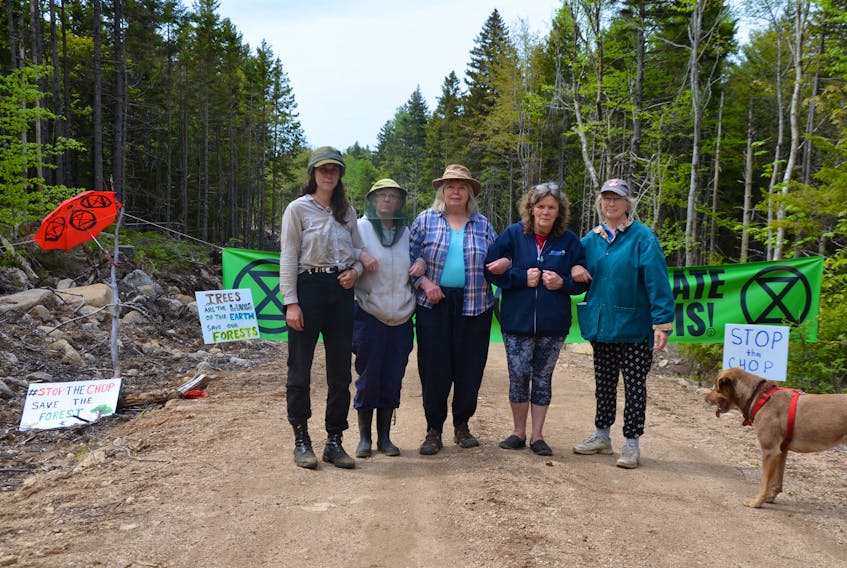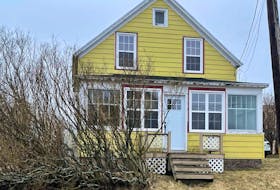WEST DALHOUSIE, N.S. — While harvest of an old Crown forest south of Bridgetown hasn’t started, Annapolis County residents who want the biodiverse woods saved from the axe will keep pressure on government.
They were back in the woods late June 11 and stayed the night after Lands and Forestry Minister Iain Rankin reaffirmed that afternoon that WestFor Management Inc. will start cutting.
Nina Newington, with Extinction Rebellion Forest Protectors, lead a protest early on June 9, the day harvesting at the small peninsula between Corbett and Dalhousie lakes could have started according to a WestFor sign. They blocked off the end of a logging road that runs the length of the 85-hectare Crown forest land from 8 to 11 a.m.
If WestFor had showed up with logging equipment they would have tried to, through non-violent direct action, stop them cutting. If WestFor didn’t arrive, she wanted to have people on hand to send them the message that people are concerned about that forest.
Newington and several others pitched a tent on the logging road and slept there over night.
The next morning half a dozen XR members and supporters were back at the site, including XR member Olga Comeau who said she’s always been a bit of a forest protector.
“I have a forest that I live in myself, which I love dearly,” she said. “It really bothers me to see what’s been done to the Crown land which I really feel is our land. It’s the people’s land. We should very much have a say in what is done with Crown land. I don’t think clear-cutting, or all of the other names they’re giving clear-cutting now, has any place on Crown land in Nova Scotia.”
Comeau said the section of old forest on the peninsula is known to be home to bears, coyotes, and all kinds of migratory birds.
NESTING SEASON
“And it’s nesting season for those birds right now,” she said. “It’s illegal to do a cut when there’s nesting birds. Some of those are even species that are protected like the chimney swift.”
More than a dozen migratory birds have been identified in the old forest.
“They’re birds that need forests like this after migrating this far north,” said Comeau. “This is the type of forest they need, a hardwood forest to do their nesting and raise their young in.”
She joined Extinction Rebellion pretty much as soon as it came to Nova Scotia.
“I think it’s really important. I think it’s really the only choice we have left is to protest non-violently and very respectively so the people’s will is becoming known,” she said.
“It’s on my way home,” said local resident Debbie Stultz-Giffin. “We’re actually the closest fulltime residents living nearest to this piece of forest in the West Dalhousie area.”
Stultz-Giffin is frank in her description of what has, and is, happening.
“Certainly the devastation from clear-cutting has been going on on this mountain for a good number of years – in the ball park of at least 30 years,” she said. “But certainly the last four or five years it’s ramped up considerably, becoming much more noticeable, certainly in broad view of the road and people passing by. People are getting fed up with these atrocities and the blatant abuse of our forests.”
SLAUGHTER
She said it looks like a slaughter.
“It’s ecological rape. It’s absolutely disgusting,” she said. “I was completely heartbroken when I came across the first patch of clear cut and it’s been nothing but heartache ever since in looking at the forest that once was that’s totally stripped and gone with random trees here and there and the odd little cluster.”
She’s noticed a decrease in wildlife, particularly songbirds.
“We’ve had bear roaming through our yards, and certainly we have heard the odd moose in the distance through the years coming from this general direction,” she said. “There’s Blandings Turtles known to be in the canal. It’s a real concern for local folks what’s happening with the forest. The forest is certainly more than the trees that we see. It’s the wildlife and everything else that’s in it.”
Local naturalist Bev Wigney lead a group of about 20 concerned citizens through the old forest on Boxing Day of 2018 and that’s when biologists, environmentalists, ecologists, and other experts realized the significance of the small woods.
“We discovered a forest of a type that is becoming rare in Annapolis County -- an ecologically
significant ‘old forest’ with many long-lived hardwood trees, the like of which we so rarely see these days,” she said. “For almost six months, a growing number of citizens of Annapolis County have worked very hard to try to stop the planned completion of the logging that was begun in
autumn 2018.”
MIGRATORY BIRDS
Like Comeau, Wigney is concerned about migratory birds and at the moment that’s her focus.
“Regardless of the industry or activity, it is illegal to disturb and destroy migratory bird habitat, nest, eggs, and young,” Wigney said. “This is clearly stated under the Migratory Birds Conventions Act.”
“It doesn't make sense for us to criticize those in countries in South and Central America for not conserving habitat where migratory species overwinter, telling them they can't cut down trees or do other harmful things to these birds, and then turn around and destroy habitat, nests, eggs and offspring up here when the birds return north to reproduce,” she said. “Does that make sense? That's why there are laws to protect migratory bird species.”
She said there may be other species in this forest - possibly even one or two listed as Species at Risk.
“We have reports by local landowners that there may be Blanding's Turtles in the lake - as yet unconfirmed,” she said. “Given that we've seen Chimney Swifts in the area of where there are huge Yellow Birch with hollows and cavities, we may well find that there are colonies of bats roosting. This is a very ecologically rich forest and there's really no limit to the interesting and possibly rare flora and fauna that we might find given enough time to explore and learn.”









